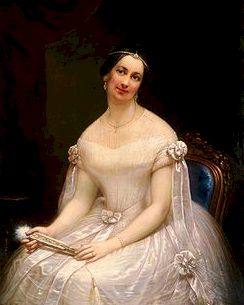|
 |

Part of the American
History & Genealogy Project |
Julia Gardiner Tyler 1820 ~ 1889


Julia Gardiner Tyler
President John Tyler married, as his second wife, Miss Julia
Gardiner, on the 26th day of June, 1844, at the Church of the
Ascension, New York City. Their wedding was the first instance
of the marriage of a President during his term of office.
Miss Gardiner was the daughter of a wealthy gentleman from
Gardiner's Island who had come upon a visit to Washington in the
winter of 1843, accompanied by his beautiful daughter. They were
invited by Captain Stockton to accompany the President and other
friends to Alexandria on the trial trip of a new ship which had
been manned by large guns. On their return, when opposite the
fort, an explosion took place which changed the merry party to
one of mourning, Miss Gardiner's father being among the number
who were killed. There were a great many lost in this accident.
The bodies of the killed were taken to the White House, from
which they were conveyed to their last resting places.
The President's marriage to Miss Gardiner took place some months
after this disaster. Mrs. Tyler was a queenly woman and presided
over the White House with exceptional grace and acceptability
for eight months prior to the expiration of President Tyler's
term of office. On his retirement they repaired to his home in
Virginia. The ex-President died in Richmond, January 17, 1862.
After the Civil War, Mrs. Tyler received from Congress a pension
which was voted to her in the winter of 1879. She had suffered
great pecuniary losses after the death of her husband, and it
was proper that she should receive this recognition of her
husband's services to his country. For many years she resided in
Georgetown, D. C, and being a devout Catholic, found it
agreeable to be near the Greorgetown Convent, where her daughter
was educated. She died in 1889.
Women of
America

Source: The Part Taken by Women in
American History, By Mrs. John A. Logan, Published by The Perry-Nalle
Publishing Company, Wilmington, Delaware, 1912.
|